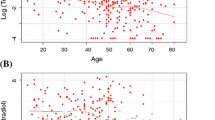Abstract
There are studies concerning the association among endogenous sex steroids, growth hormone (GH), insulin-like growth factor-I (IGF-I) and bone mineral density (BMD) in both men and women. However, little is known concerning the association of these parameters with markers of bone turnover in healthy elderly men. We studied the association of BMD (dual energy X-ray absorptiometry of spine, hip and forearm) and markers of bone turnover (bone-specific alkaline phosphatase, serum C-terminal propeptide of type I collagen, and serum osteocalcin reflecting formation, urine deoxypyridinoline and calcium excretion in relation to creatinine excretion reflecting resorption) with endogenous sex steroids, GH and IGF-I in 14 elderly normal men (age range 60–79 years). There was a negative correlation between age and dehydroepiandrosterone sulphate (DHEAS) (r=−0.60, p=0.022) and a positive correlation between GH and IGF-I (r=0.53, p=0.048). Serum estradiol concentrations correlated with BMD at distal 1/3 radius (r=0.41, p=0.1) and mid-radius (r=0.47, p=0.08), and negatively correlated with age (r=−0.45, p= 0.09). There was no correlation of estradiol with bone turnover markers, testosterone, free testosterone, DHEAS, GH and IGF-I. Serum GH and IGF-I levels showed no correlation with BMD (all sites) and bone turnover markers. Serum total testosterone concentrations positively correlated with BMD at distal 1/3 radius (r=0.47, p=0.09), femoral neck (r=0.56, p=0.037) and Ward’s triangle (r=0.49, p=0.07). These data suggest that serum estradiol and testosterone levels are associated with BMD in elderly men, possibly indicating their contribution to skeletal maintenance in old age. However, correlations of IGF-I, GH and DHEAS with BMD and bone turnover markers are lacking in the group studied.
Similar content being viewed by others
References
Richelson L.S., Wahner H.W., Melton L. J. III Relative contributions of aging and estrogen deficiency to postmenopausal bone loss. N. Engl. J. Med. 1984, 311: 1273–1275.
Greenspan S.L., Neer R.M., Ridgway E.C., Klibanski A. Osteoporosis in men with hyperprolactinemic hypogonadism. Ann. Intern. Med. 1986, 104: 777–782.
Anderson F.H., Francis R.M., Peaston R.T., Wastell H.J. Androgen supplementation in eugonadal men with osteoporosis: effect of six months treatment on markers of bone formation and resorption. J. Bone Miner. Res. 1997, 12: 472–478.
Smith E.P., Boyd J., Frank G.R., Takahashi H., Cohen R.M., Specker B., Williams T.C., Lubahn D.B., Korach K.S. Estrogen resistance caused by a mutation in the estrogen-receptor gene in a man. N. Engl. J. Med. 1994, 331: 1056–1061.
Carani C., Qin K., Simoni M., Faustini-Fustini M., Serpente S., Boyd J., Korach K.S., Simpson E.R. Effect of testosterone and oestradiol in a man with aromatase deficiency. N. Engl. J. Med. 1997, 337: 91–95.
Morishima A., Grumbach M.M., Simpson E.R., Fisher C., Qin K. Aromatase deficiency in male and female siblings caused by a novel mutation and the physiological role of estrogen. J. Clin. Endocrinol. Metab. 1995, 80: 3689–3698.
Gillberg P., Johansson A.G., Ljunghall S. Decreased oestradiol levels and free androgen index and elevated sex hormone-binding globulin levels in male idiopathic osteoporosis. Calcif. Tissue Int. 1999, 64: 209–213.
Jones J.I., Clemmons D.R. Insulin-like growth factors and their binding proteins: biological actions. Endocr. Rev. 1995, 16: 3–32.
Kurland E.S., Rosen C.J., Cosman F., McMahon D., Chan F., Shane E., Lindsay R., Dempster D., Bilezikian J.P. Insulin-like growth factor-I in men with idiopathic osteoporosis. J. Clin. Endocrinol. Metab. 1997, 82: 2799–2805.
Ljunghall S., Johansson A.G., Burman P., Kampe O., Lindh E., Karlsson F.A. Low plasma levels of insulin-like growth factor I (IGFI) in male patients with idiopathic osteoporosis. J. Intern. Med. 1992, 232: 59–64.
Delmas P.D. Biochemical markers of bone turnover: methodology and clinical use in osteoporosis. Am. J. Med. 1991, 91 (Suppl. 5B): 59S–63S.
Canalis E., McCarthy T., Centrella M. Growth factors and the regulation of bone remodeling. J. Clin. Invest. 1988, 81: 277–281.
Rosen C., Donahue L.R., Hunter S.J. Insulin-like growth factors and bone: the osteoporosis connection. Proc. Soc. Exp. Biol. Med. 1994, 206: 83–102.
Holmes S.J., Shalet S.M. Role of growth hormone and sex steroids in achieving and maintaining normal bone mass. Horm. Res. 1996, 45: 86–93.
Greendale G.A., Edelstein S., Barrett-Connor E. Endogenous sex steroids and bone mineral density in older women and men: the Rancho Bernardo Study. J. Bone Miner. Res. 1997, 12: 1833–1843.
Slemenda C.W., Longcope C., Zhou L., Hui S.L., Peacock M., Johnston C.C. Sex steroids and bone mass in older men: positive associations with serum estrogens and negative associations with androgens. J. Clin. Invest. 1997, 100: 1755–1759.
Center J.R., Nguyen T.V., Sambrook P.N., Eisman J.A. Hormonal and biochemical parameters in the determination of osteoporosis in elderly men. J. Clin. Endocrinol. Metab. 1999, 84: 3626–3635.
Drinka P.J., Olson J., Bauwens S., Voeks S., Carlson I., Wilson M. Lack of association between free testosterone and bone density in elderly men. Calcif. Tissue Int. 1993, 52: 67–69.
Murphy S., Khaw K., Cassidy A., Compston J.E. Sex hormones and bone mineral density in elderly men. Bone Miner. 1993, 20: 133–140.
Barrett-Connor E., Kritz-Silverstien D., Edelstein S.L. A prospective study of dehydroepiandrosterone sulphate and bone mineral density in older men and women. Am. J. Epidemiol. 1993, 137: 201–206.
Author information
Authors and Affiliations
Corresponding author
Rights and permissions
About this article
Cite this article
Gürlek, A., Gedik, O. Endogenous sex steroid, GH and IGF-I levels in normal elderly men: Relationships with bone mineral density and markers of bone turnover. J Endocrinol Invest 24, 408–414 (2001). https://doi.org/10.1007/BF03351040
Accepted:
Published:
Issue Date:
DOI: https://doi.org/10.1007/BF03351040




